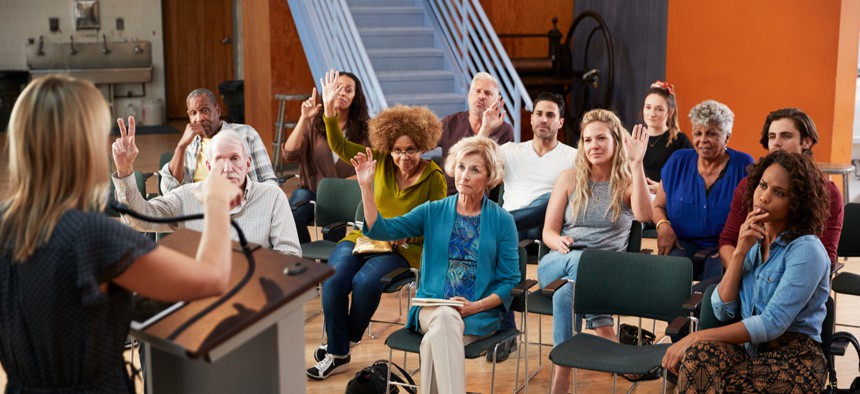How Local Governments Can Get Feedback From a More Diverse Range of Residents

Some communication experts recommend focus groups for hard-to-reach residents. Shutterstock
Participation in local government often skews heavily toward white residents, elderly people, and homeowners.
In 2018, the city of Portsmouth, Virginia wanted to get feedback on their upcoming budget, so they created a survey to gauge public opinion. Though Portsmouth is a majority-Black city with a median age of 35, most of the people who responded were white and older than 50.
Portsmouth isn’t the first or the last local government to have a hard time reaching some of their residents. When Brooklyn Park, Minnesota recently surveyed their community about the impact of Covid-19, white residents and homeowners were overrepresented among respondents. When Evanston, Illinois surveyed their residents about equity in the community, they heard from people who were older and richer than the average resident, while Hispanic and Asian residents were significantly underrepresented.
These surveys and other methods of local government participation illustrate how the hardest populations for local governments to reach are often racial and ethnic minorities, young people, low-income residents, undocumented immigrants, and those who speak a first language other than English—the exact groups that may be in most need of local government services.
Without a diversity of voices, policy decisions can fail to accurately represent the desires and needs of a city or county population, said Angelica Wedell, the marketing director for Polco/National Research Center, a survey research firm that focuses on the public sector.
“Especially these days, we have very diverse communities and there’s a lot of challenges that come along with that,” she said. “Are resources equitable and distributed fairly among communities? … We have to deal with all these things and make engagement easier for all of our residents so we can hear from them.”
At a session during the annual conference of the International City/County Management Association about how to gather the opinions of hard-to-reach residents, speakers explained how local governments can take steps to engage a broader swath of their communities in surveys and other feedback opportunities.
The first step to getting more feedback is to make a plan specifically designed to engage people who are hard to reach, said Michelle Kobayashi, the vice president of Polco/NRC.
“Look for the folks you don't hear from as much and spend more resources to get those people into your decision making,” she said.
Bringing in new voices can mean creating partnerships with local community organizations and trusted leaders who can “establish trust, legitimacy, and continue that relationship throughout the process” of getting feedback. It can also mean using culturally relevant practices, especially for people with limited English proficiency or those who may lack trust in the government, like undocumented immigrants.
Local government leaders should also capitalize on the ease of technology to draw more people in throughout the policy lifecycle, from general surveys to crowdsourcing policy ideas to collecting input on specific proposals. “Not everybody has three hours to attend a council meeting, but most people have five minutes to answer questions on their cell phone,” said Kobayashi.
When creating new ways for residents to provide feedback, take care to avoid the “language of government,” said Carroll Robinson, a professor of public administration and political science at Texas Southern University and a former member of the Houston City Council. Confusing language is a frequent barrier for people who don’t participate in local government surveys or meetings—but it’s an easy one to overcome. “Watch yourself so you don't start talking in acronyms or sound bites,” he said. “Everybody doesn't have the same common base of knowledge.”
With more residents providing feedback, local governments may be worried about the type of responses they receive. Those who frequently participate in local government are often highly impassioned and opinionated, but that won’t necessarily be the case with a broader sample, said Nick Mastronardi, the CEO of Polco/NRC. If local governments expand the number of ways people can provide feedback—though town halls, focus groups, mailed surveys, digital feedback forms, and more—the percentage of people who are “squeaky wheels” decreases, he said.
“When we make things difficult to hear from residents, all we’re hearing are the extreme voices,” Mastronardi said. “If we can do things to lower the barrier to participation, we hear from more moderate, more thoughtful voices.”
Engaging those residents now, during a time of both civil unrest and a public health crisis, will be more important than ever.
“There are so many new and important decisions facing our communities in tandem,” said Mastronardi. “In order to make those decisions correctly, to help navigate the best recovery we can in terms of public health, public safety, economic recovery … it’s critically important that we’re in constant communication, building trust, and hearing from our community.”
Emma Coleman is the assistant editor for Route Fifty.
NEXT STORY: CDC Pulls Updated Guidance on Coronavirus Spread, Saying it was Posted By Mistake






